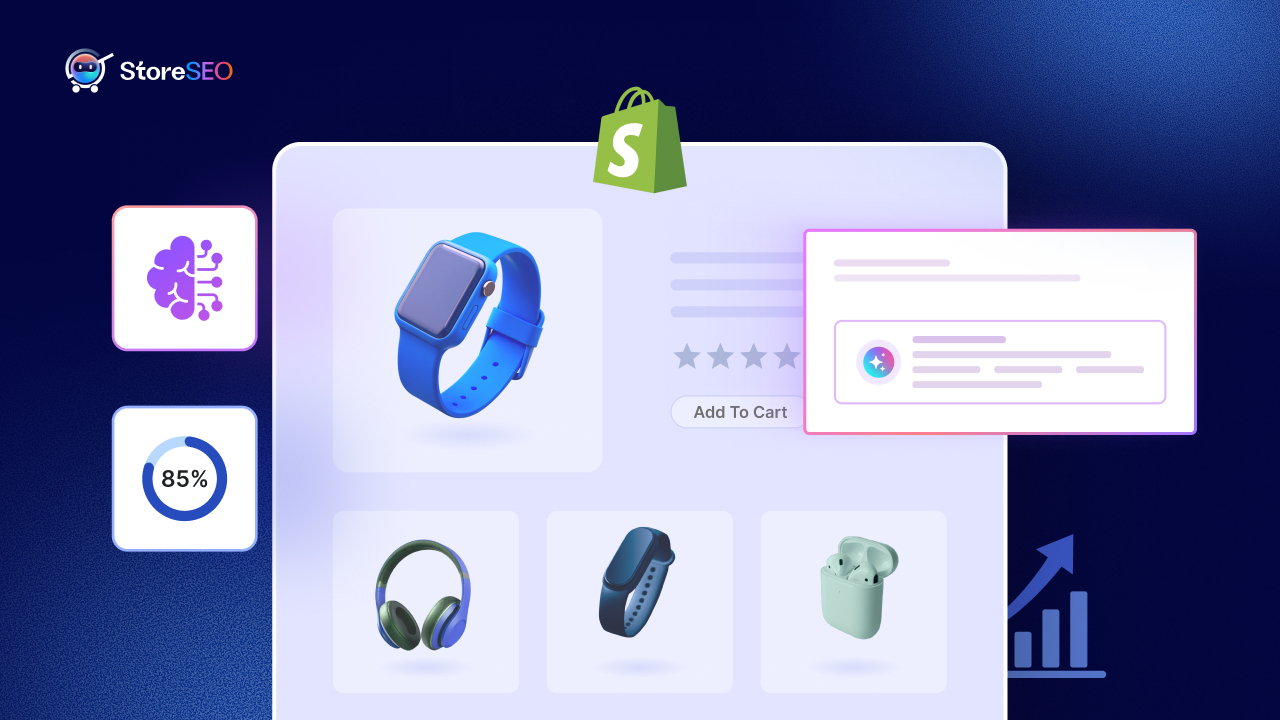From descriptions and images to reviews and pricing, the PDP plays a critical role in helping customers make informed decisions. But did you know that a well-optimized PDP can also boost your website’s visibility on search engines? Let us dive into what PDPs are, their importance, and how they contribute to eCommerce SEO.

What is a Product Detail Page (PDP) in eCommerce?
A Product Detail Page (PDP) is a specific webpage in an eCommerce store that provides all the essential information about a particular product. Think of it as the digital version of a product displayed in a physical store.
It is where customers go to learn about the product’s features, see images or videos, check pricing, read reviews, and decide whether to make a purchase. Essentially, it acts as the cornerstone of online shopping, offering everything shoppers need to make informed decisions.
As a product detail page, it is dedicated to showcasing the product in detail and answering any questions potential buyers might have. This page typically includes high-quality images, detailed descriptions, pricing information, availability status, and customer reviews. It also has interactive elements like “Add to Cart” or “Buy Now” buttons to encourage purchases.
Core Components of a PDP In eCommerce
A well-designed PDP In eCommerce includes several key elements that work together to create an informative and engaging shopping experience:
- Product Images and Videos: High-quality visuals are essential since customers cannot physically see or touch the product. Multiple images from different angles or even videos showing how the product works help build confidence.
- Product Title: A clear and concise title tells shoppers exactly what they are looking at. It should be easy to understand and prominently displayed at the top of the page.
- Product Description: This section provides details about the product’s features and benefits. It explains why the product is worth buying and often includes technical specifications like size, material, or functionality.
- Pricing Information: The price must be visible. If there are discounts or promotions, these should also be highlighted to grab attention.
- Customer Reviews and Ratings: Reviews help build trust by showing what other buyers think of the product. Positive feedback can encourage hesitant shoppers to make a purchase.
- Call-to-Action (CTA) Buttons: These buttons guide customers on what to do next. Common examples include “Add to Cart,” “Buy Now,” or “Add to Wishlist.” They should be easy to spot and simple to use.
- Shipping Information: Details about delivery options, estimated arrival times, and shipping costs are often included so customers know what to expect after purchasing.
- Policies: Information about returns, warranties, or privacy policies reassures customers that they can shop with confidence.
Why Are PDPs Crucial for eCommerce Success?
PDP In eCommerce acts as the digital equivalent of a knowledgeable salesperson, providing all the essential details a shopper needs to make a confident purchase decision. Let us explore why these pages are so critical to the success of online businesses.
How PDP In eCommerce Influence Customer Decision-Making
When shopping online, customers cannot physically touch or try products. This makes PDPs the primary source of information for their decision-making. A well-designed PDP In eCommerce answers all potential customer questions—such as product features, dimensions, materials, pricing, and even reviews from other buyers.
Imagine you are looking for a pair of headphones. A good PDP will provide details like sound quality, battery life, connectivity options, and customer testimonials. This comprehensive information helps you feel confident about your choice and reduces hesitation.
Moreover, PDPs can guide customers by highlighting unique selling points (USPs). For instance, if a product is eco-friendly or comes with a warranty, this could be the deciding factor for someone who values sustainability or long-term reliability.
Boost Conversions and Build Trust To Reduce Cart Abandonment
Cart abandonment is one of the biggest challenges in eCommerce. Many shoppers leave without completing their purchase because they feel uncertain or do not find enough information on the product page. A strong PDP In eCommerce addresses this issue by providing clarity and reassurance.
- Trust-Building Features: Including trust badges (like secure payment icons), clear return policies, and verified customer reviews can make shoppers feel more secure about their purchases.
- Transparency: Detailed descriptions and high-quality images reduce doubts and increase trust in your brand. For example, showing multiple angles of a product or videos demonstrating its use can bridge the gap between online and in-store experiences.
- Social Proof: Customer reviews and ratings play a huge role in reducing uncertainty. When potential buyers see positive feedback from others, they are more likely to proceed with their purchase
The Connection Between PDP In eCommerce and SEO
Search engine optimization (SEO) is essential for individual product detail pages (PDPs) because it ensures that these pages are visible in search engine results. When someone searches for a specific product, such as “red leather backpack,” the goal is for your product page to appear among the top results.

SEO achieves this by optimizing various elements of the page, such as the title, meta description, URL structure, and content. For example, including keywords like “red leather backpack” in these areas helps search engines understand the relevance of your page to the user’s query.
Structured data also plays a significant role in SEO for PDP In eCommerce. By using schema markup, you can provide search engines with detailed information about your product, such as its price, availability, and customer reviews. This increases the likelihood of your product appearing in rich snippets, which are visually appealing search results that can boost click-through rates.
Why Well-Optimized PDP In eCommerce Improves Search Rankings and Organic Traffic
Optimized PDP In eCommerce improves search rankings because they align closely with user intent. When users search for specific products using detailed queries (e.g., “men’s size 12 brown boots”), they are often ready to make a purchase. A well-optimized PDP In eCommerce that matches these queries is more likely to rank higher on search engine results pages (SERPs). This is because search engines prioritize pages that directly satisfy user needs.

Higher rankings lead to increased organic traffic—visitors who find your site through unpaid search results. Organic traffic is valuable because it typically includes users who are actively searching for products like yours and are more likely to convert into customers. For example, if your PDP includes clear product descriptions, optimized images, and relevant keywords, it will attract more purchase-ready visitors.
Additionally, optimized PDP In eCommerce enhances user experience by providing clear and accurate information about products. This reduces bounce rates and encourages visitors to explore other parts of your website, further boosting overall traffic.
The Importance of Targeting Transactional and Commercial Intent Keywords for PDP In eCommerce
Transactional and commercial intent keywords are crucial for PDP optimization because they indicate a high likelihood of purchase. Transactional keywords include terms like “buy,” “order,” or “for sale,” signaling that the user is ready to take action immediately. Commercial intent keywords focus on comparisons or evaluations (e.g., “best DSLR cameras for beginners”), showing that the user is close to making a decision.

By targeting these keywords on your PDPs, you can attract users who are further along in their buying journey. For instance, a keyword like “buy iPhone 12” suggests that the user has already decided on the product and is looking for a place to purchase it. Optimizing PDP In eCommerce with such keywords ensures it meets this intent directly, increasing conversions.
Key SEO Strategies for Optimizing Product Detail Pages (PDPs)
Product Detail Pages (PDPs) are one of the most important parts of any eCommerce website. These pages are where customers decide whether to make a purchase, so it is essential to ensure they are optimized for search engines and user experience. By following key SEO strategies, you can improve the visibility of your PDP In eCommerce industry to attract more visitors, and ultimately increase sales. Let us take a closer look at each strategy and how it can benefit your online store.
Keyword Research: Importance of Using Relevant Keywords
Keywords are the building blocks of effective SEO. They help search engines understand what your page is about and connect it with users searching for similar products. For PDP In eCommerce, it is important to use relevant keyword research in key areas such as product titles, meta descriptions, and headings.

For example, if you are selling “stainless steel water bottles,” this phrase should appear naturally throughout the page. Including long-tail keywords, like “insulated stainless steel water bottle 32 oz,” can also be highly effective because these phrases are more specific and often have less competition. When you use the right keywords in the right places, your PDPs become more likely to rank higher in search results and attract potential customers.
Unique Content: Avoiding Duplicate Descriptions
One common mistake many eCommerce websites make is using duplicate content for their product descriptions. This often happens when businesses copy descriptions provided by manufacturers or reuse the same text across multiple pages. Unfortunately, search engines penalize duplicate content because it does not add value to users.
To stand out and improve your rankings, you should create unique and engaging descriptions for each product. Focus on highlighting what makes the product special and how it benefits the customer. Instead of simply listing features, explain how those features solve a problem or enhance the user’s life.
For example, instead of saying “This jacket is waterproof,” you could say “Stay dry and comfortable even in heavy rain with this waterproof jacket.” Writing original, keyword-rich content not only improves SEO but also makes your products more appealing to shoppers.
Image Optimization: Improving Speed and Accessibility
Images play a vital role in making PDP In eCommerce visually appealing and informative. However, if images are not optimized properly, they can slow down your website and hurt both user experience and search rankings. To optimize images, start by using descriptive file names instead of generic ones like “IMG1234.”

For example, name an image “red-leather-handbag.jpg” to provide context to search engines. Include alt text for every image, describing what it shows while incorporating relevant keywords when appropriate. Alt text not only helps with SEO but also improves accessibility for visually impaired users who rely on screen readers.
Compressing images is another important step; large image files can make your pages load slowly, which frustrates visitors and may cause them to leave before making a purchase. Using modern formats like WebP can further reduce file sizes without compromising quality.
Rich Snippets: Enhancing Search Visibility
Rich snippets are an excellent way to make your PDP In eCommerce stand out in search results by providing additional information such as prices, reviews, ratings, or availability directly on the results page. These extra details catch the user’s eye and encourage them to click on your link over others. To enable rich snippets for your PDP.
In eCommerce, you can use schema markup—a type of structured data that communicates specific details about your product to search engines. Also, you can use Shopify apps like: StoreSEO to make these implementation processes easy.

For instance, if someone searches for “affordable wireless headphones,” a rich snippet showing the price range or star rating of your product can make all the difference in attracting their attention. By leveraging rich snippets effectively, you not only improve click-through rates but also build trust with potential customers by offering useful information upfront.
Internal Linking: Improving Navigation and SEO Value
Internal linking is an often-overlooked yet powerful SEO strategy that benefits both users and search engines. By linking PDP In eCommerce to related products or category pages within your website, you create a seamless navigation experience for visitors while helping search engines understand the structure of your site. For example, if a customer is viewing a leather handbag on your site, you could include links to other similar handbags or accessories they might like.

This encourages them to explore more products and increases their chances of making a sale. From an SEO perspective, internal links distribute link authority across different pages of your site, boosting their rankings over time. It is also helpful to use clear and descriptive anchor text for these links so users know exactly where they will be taken when they click.
Mobile Optimization: Ensuring a Seamless Experience
With mobile devices accounting for a large majority of online shopping traffic today, optimizing PDP In eCommerce for mobile is no longer optional—it is essential. A mobile-friendly design ensures that customers have a smooth browsing experience regardless of the device they are using. Start by making sure your website has a responsive design that adjusts automatically to different screen sizes.

Fast loading times are equally critical; no one likes waiting for slow pages to load, especially on mobile devices where patience tends to be even shorter. Compressing images, minimizing unnecessary code, and enabling browser caching can all help speed up your site’s performance on mobile devices.
Focus on creating user-friendly features such as large buttons that are easy to tap and simple navigation menus that do not overwhelm users with too many options at once. Since Google prioritizes mobile-first indexing—meaning it evaluates websites based on their mobile versions—having an optimized mobile design directly impacts your search rankings.
Optimized PDPs for eCommerce SEO Drives Growth & Visibility
Optimized PDP In eCommerce SEO is important because it helps your products rank higher on search engines like Google. By using the right keywords, structured data, and clear, engaging content, your products become more visible to potential customers. Well-optimized PDP In eCommerce also improves user experience with better images, easy navigation, and mobile-friendly designs, which keep visitors on your page longer and reduce bounce rates. This not only boosts your search rankings but also drives consistent organic traffic without relying heavily on paid ads. Over time, this approach saves money, builds trust with customers, and ensures steady growth for your online store.
Have you found our blog useful? If you do, please subscribe to our blog for more tips, tutorials, and updates on industry-related topics.









